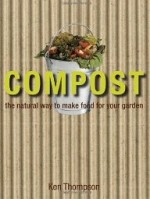 As gardeners we all want to do the right thing and composting is high on the list. For some of us, however, the thought of a pile of rotting vegetation is not appealing and the prospect of turning over that pile is daunting. Ken Thompson’s book on composting provides the reader with easily understood facts and tips that may inspire enthusiasm in even the most reluctant gardener.
As gardeners we all want to do the right thing and composting is high on the list. For some of us, however, the thought of a pile of rotting vegetation is not appealing and the prospect of turning over that pile is daunting. Ken Thompson’s book on composting provides the reader with easily understood facts and tips that may inspire enthusiasm in even the most reluctant gardener.
The book is divided into five sections beginning with basic information including the importance of composting, the factors involved in the composting process, and good and bad compost making materials. The compost pile is viewed as an ecosystem with many different organisms living there and doing their part in turning waste into black gold. Further attention is given to the importance of temperature, water, and air in creating a proper environment for these organisms so the full potential of the compost pile can be attained.
The second section deals with making the compost. The classical directions are given with the remark that “simple advice is riddled with weasel words that gloss over real difficulties.” Thompson then turns to considering the problems that most gardeners have like accumulating enough waste at one time. He compares making a compost pile to doing the laundry; it is a batch process, so what do you do with waste until you have enough? “Keep it in the refrigerator, maybe?” His good sense of humor continues to carry us along as he considers some of the other traditional problems such as adding water when the pile seems dry and heat builds up. The bulk of the chapter is devoted to giving concrete realistic suggesting for creating a compost pile including advice on soft waste, worms, and dealing with woody waste. He calms the nervous gardener with the words “no turning is required.”
The third section deals with bins. Wood, plastic and other options such as bales of hay, tires, and plastic bags filled with rotting leaves are discussed with pros and cons given for each. Worm bins are discussed with the conclusion that they are not as simple as some believe and that “If you wouldn’t even consider keeping rabbits or a hamster then a worm bin is probably not for you.”
At some point your compost will be ready, but when? Thompson gives us the good news that readiness is a personal matter and gives some guide lines for making the decision. Although the vegetable garden is the ideal place to use compost because its effects are so measurable there, all plants in the garden can benefit especially when applied while the soil is moist. Thompson points out that compost can be applied as a mulch and does not have to be dug in. More good news.
A final section is for those who still resist the idea of having a compost pile. Thompson makes suggestions for using garden waste without making a formal pile in an out of the way place. He also discusses the use of green manure, a crop that is grown and then ploughed into the soil so it adds organic matter, as a way of improving the soil in a natural way.
The text is accompanied by photographs and sketches that emphasize the material presented and add to the enjoyment of the text. Variation of font sizes draws attention to the major points and gives the reader a sense of movement through the information, adding to a buildup of enthusiasm. Having debunked some of the myths of composting, Thompson presents an easy practical way of composting in a clear and enjoyable book that makes composting look almost fun.
To buy Compost: The natural way to make food for your garden from Amazon.com click here.